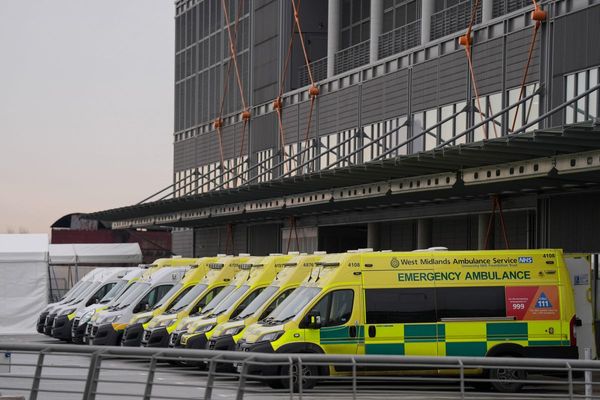
Fast Facts
- TheStreet spoke with former NASA administrator Sean O’Keefe regarding the risk of ever-increasing quantities of space debris orbiting Earth.
- There are currently about 9,000 functional satellites in orbit, according to the European Space Agency.
- Private corporations including SpaceX and Amazon have plans to launch tens of thousands of satellites.
Space may well be infinite, but the space around Earth is not.
Nearly 17,000 satellites have been launched into orbit since the 1950s, according to the European Space Agency. Close to 12,000 of those remain in orbit today, though only 9,000 are active.
Space surveillance networks are additionally tracking more than 35,000 pieces of space debris in orbit around the planet. In total, there are more than 11,000 tons of mass orbiting Earth.
The number of orbiting objects, meanwhile, is expected to continue rising in the coming years. SpaceX operates a constellation of around 5,000 Starlink satellites; the company has approval to boost that number to 12,000 and is adding to the constellation seemingly every other day.
Related: Watch Elon Musk's SpaceX launch Starship: Third time's the charm
But 12,000 isn't enough — SpaceX has plans to operate a constellation of 40,000 or more internet satellites.
And SpaceX isn't alone in this push to boost satellite numbers. Amazon has plans to launch around 3,000 similar satellites over the next six years as part of its Project Kuiper program. Launch company Astra Space is likewise looking to launch a constellation of more than 13,000 satellites.
Research and consulting firm Quilty Space said last year that it expects 20,000 new satellites to be launched by 2030.
And with SpaceX leading the way with rocket reusability, space has never been as accessible as it is today, something that Syracuse University professor and former NASA administrator Sean O’Keefe said is a largely positive reality, though it carries certain threats.
O'Keefe told TheStreet that the ever-increasing crowds of junk orbiting the planet is an "accident waiting to happen."
Related: SpaceX investor explains how to invest in space
The threat of an over-crowded orbit
The problem of all this space ... stuff ... O'Keefe told TheStreet, is two-fold.
First, he said that it doesn't take much to cause a mid-orbit collision, something that could damage or destroy active satellites or spacecraft.
"It's the equivalency of looking at traffic jams on the interstate highways," O'Keefe said, adding that the difference is that in orbit, spacecraft lack the option of braking and laying on the horn. "Everything's still traveling at 17,500 miles an hour whether you like it or not."
Former NASA scientist Donald Kessler first warned of this in a 1978 paper that highlighted the risk of satellite collisions.
Kessler warned that in-orbit collisions could create more and more space debris, which would create more collisions, creating more debris, creating more collisions, in a loop that would eventually create a belt of debris around the planet. This theoretical belt could severely impact the viability of rocket launches, space exploration and functional satellite technology.
Indeed, such collisions have already occurred, though not yet on an existential scale. In 2009, active communications satellite Iridium 33 crashed into a defunct Russian satellite, producing nearly 2,000 pieces of orbital space debris.

Since the year 2000, the International Space Station has had to dodge space junk more than 30 times; in 2021 it sustained minor damage after being struck by a two-inch-long piece of debris.
The other problem, O'Keefe said, is the risk of debris raining down on Earth if satellites are not universally designed to burn up upon re-entry into the atmosphere.
The Federal Aviation Administration said in a report last year that nearly 30,000 "hazardous fragments" could survive re-entry in 2035, resulting in damage to airplanes or injury to people. The agency added that the probability of this occurring by then is low.
"The best we can really do right now is hope that it comes down in place not to hurt anybody," O'keefe said. "And so far we're getting very lucky."
Related: SpaceX slams report implicating it in a potential threat to 'people on Earth'
Space, the Final Frontier Wild, Wild West
But the core problem here, according to O'Keefe, is that the situation is an international one. And currently, there is no universal authority to enforce standards within and around low-Earth orbit.
"There's no governance structure for it that really was ever designed to deal with something of this size. It is mostly based on a fundamental proposition of everyone acting in their own best interests," he said, adding that though there are governance structures for rocket launches, "once you're 10 minutes off this rock it's pretty much the Wild West."
O'Keefe said that current systems lack coordination.
He stressed the importance of developing a governance structure that, importantly, would have the authority to prevent launches unless companies (or government agencies) meet certain conditions concerning what will happen with a given asset upon deactivation.
The first requirement for such governance, O'Keefe said, must be that satellites are designed to burn up completely upon deactivation. "Otherwise, we're creating a lot of debris."
Fortunately, he said that many companies are already falling in line with that standard.
SpaceX's satellites, for example, are "designed and built to fully demise during atmospheric reentry during disposal at end of life, and they do so,” according to the company's principal engineer.
Such practices, however, are not universally enforced.
Some groups, including NASA and the Space Safety Coalition, are working both to create guidelines for best practices and to figure out ways to clean up the debris currently in orbit.
There have been proposals to clear up some debris using nets.
While such efforts are promising, O'Keefe said that the intractable problem is that space debris is a global issue, which would require governments around the world to agree to a set of responsible, logical standards and mitigation for existing debris.
He's not optimistic that such an international agreement could be reached anytime soon.
“There is no international entity with policing authority, or reliable capability for that matter, to retrieve space junk or take rogue satellites out of orbit," he said. "That’s not likely to change since few global nation states are willing to cede sovereignty and permit a foreign entity to govern space traffic.”
Contact Ian with tips and AI stories via email, ian.krietzberg@thearenagroup.net, or Signal 732-804-1223.
Related: SpaceX investor says Starship will open up 'entirely new markets'







